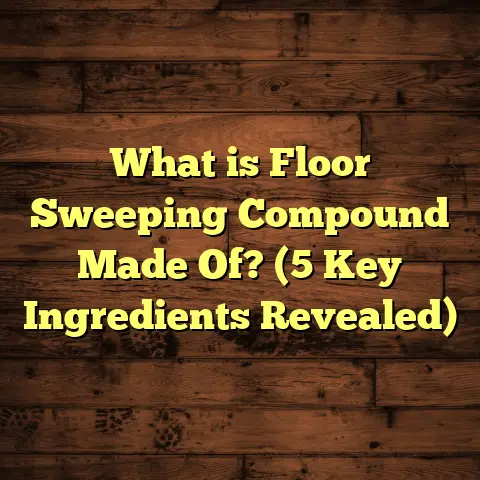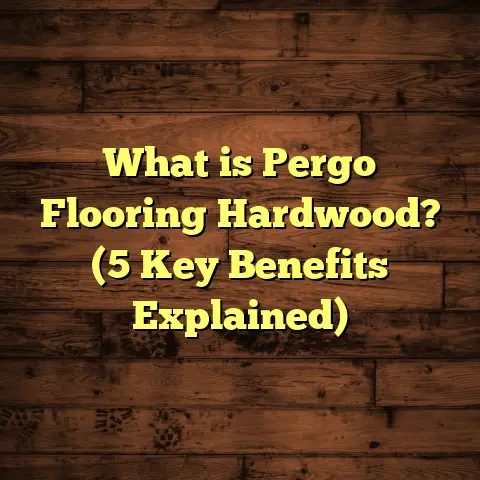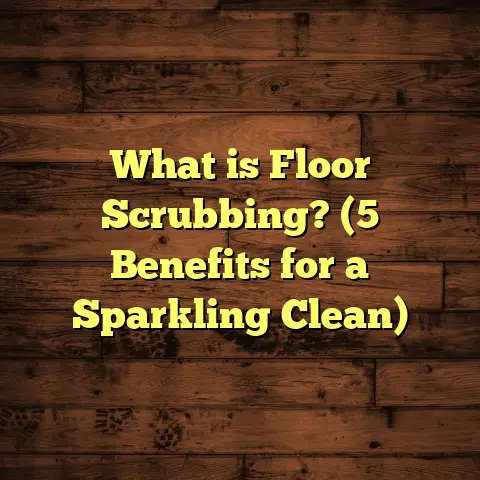What is Safe Laminate Flooring? (5 Benefits for Your Home)
I used to think laminate flooring was just a cheap, flimsy alternative to hardwood. You know, that stuff that looks okay from afar but feels synthetic and low-quality underfoot? Well, I couldn’t have been more wrong. After installing safe laminate flooring in several homes and digging into the details, I realized it’s a serious contender for anyone wanting durable, stylish, and safe floors. So, what exactly is safe laminate flooring, and why should you care? Let me walk you through it.
What Is Safe Laminate Flooring?
Safe laminate flooring is a type of synthetic flooring designed not only to mimic the look of natural wood or stone but also to meet strict safety standards concerning materials, emissions, and installation. Unlike traditional laminate, which sometimes raised concerns over chemicals like formaldehyde or flammability, safe laminate floors are manufactured with enhanced materials and treatments to minimize health risks and improve durability.
The core of laminate flooring is typically made from high-density fiberboard (HDF) or medium-density fiberboard (MDF), crafted from wood fibers compressed under heat and pressure. This core is topped with a photographic applique layer that simulates wood grain or stone patterns, sealed by a protective wear layer to resist scratches and moisture. What sets safe laminate apart is the use of low-emission adhesives, non-toxic finishes, and additional treatments that reduce the risk of off-gassing harmful compounds.
Manufacturers producing safe laminate often comply with certifications like FloorScore or GREENGUARD, which test for indoor air quality standards. These certifications ensure the flooring releases fewer volatile organic compounds (VOCs), creating a healthier environment. Plus, safe laminate flooring undergoes rigorous fire resistance testing and may include fire-retardant additives meeting local fire codes.
By design, safe laminate flooring balances aesthetics, durability, and health considerations. And thanks to ongoing technological advancements in materials science and manufacturing processes, it’s becoming easier to find products that check all these boxes without breaking the bank.
Breaking Down the Technical Side: How Safe Laminate Flooring Is Made
You might wonder what exactly makes safe laminate flooring “safe.” Let me take you behind the scenes into the manufacturing process because understanding this will help you appreciate why some laminates are better than others.
The Core Layer: High-Density Fiberboard (HDF)
Most laminate floors start with a core made of high-density fiberboard (HDF). This is essentially wood fibers compressed under extreme heat and pressure into dense panels. HDF is favored because it offers structural integrity and resistance to impact compared to medium-density fiberboard (MDF), which is less dense and durable.
The wood fibers used in HDF are usually sourced from sustainable forestry operations or recycled wood waste — this adds an environmental benefit when manufacturers choose responsibly. In safe laminate flooring, these cores are bound together using low-formaldehyde or no-added-formaldehyde adhesives. Why does this matter? Because formaldehyde is a common VOC linked to indoor air pollution and health concerns like respiratory irritation.
Decorative Layer: Photographic Imaging
On top of this core comes a printed decorative layer. This thin sheet of paper carries high-resolution images of wood grains, stone textures, or even abstract designs. The printing process increasingly uses water-based inks rather than solvent-based inks to reduce toxic emissions.
Some manufacturers even apply embossing techniques aligned with the printed pattern to enhance realism. For example, if the image shows oak grain with knots, the embossing will create tactile ridges mimicking that texture.
Protective Wear Layer
In safe laminate flooring products, this wear layer is often thicker or includes additional UV stabilizers to prevent discoloration over time. The thickness of this wear layer directly correlates with durability — typical ranges are 6-12 mils (thousandths of an inch), with premium products going even higher.
Environmental Treatments
Some manufacturers incorporate anti-microbial or anti-static treatments in their laminates. These treatments help reduce bacteria growth or static electricity buildup on floors—small but meaningful comfort factors in homes with kids or pets.
Fire-Resistant Additives
One often overlooked but crucial feature is fire resistance. Safe laminates may include fire-retardant additives within the core or surface layers to slow down ignition and reduce smoke production during a fire event.
Quality Control & Certifications
Before hitting store shelves, safe laminate flooring undergoes strict quality control checks. Producers test for VOC emissions per standards like California’s Section 01350 or GREENGUARD Gold certification criteria. They also verify wear layer durability through abrasion tests like the Taber abrasion method.
Why Safety Should Be Your Priority in Flooring Choices
You might wonder, “Why should I worry about the safety of my floors?” Here’s a bit of real talk: I’ve seen families dealing with unexplained allergies or respiratory issues, and sometimes their home’s indoor air quality was the culprit. Flooring materials can emit VOCs such as formaldehyde, which can cause headaches, dizziness, or worsen asthma symptoms.
In my experience, choosing safe laminate flooring has helped reduce these problems significantly. One case that stands out was when I helped a family with two young kids switch to low-VOC laminate flooring. They reported much better air quality and fewer allergy flare-ups within weeks of installation.
Also, safety means considering fire resistance. While no flooring is completely fireproof, safe laminate has improved ratings compared to basic laminate. This matters especially if you’re in a region prone to wildfires or simply want extra peace of mind.
5 Benefits of Safe Laminate Flooring for Your Home
Alright, so what exactly makes safe laminate flooring worth considering? I’ll share five benefits I’ve seen firsthand and back them up with data and examples.
1. Healthier Indoor Air Quality
One of the biggest upsides I’ve noticed is how safe laminate flooring supports a cleaner indoor environment. Regular laminate floors sometimes emit VOCs due to the adhesives and resins used during manufacturing. Safe laminates use low-emission materials tested to meet strict standards like FloorScore certification. This means fewer chemicals floating around in your home’s air.
Data from the Environmental Protection Agency (EPA) shows indoor air can be 2-5 times more polluted than outdoor air because of off-gassing from building materials like flooring. VOCs such as formaldehyde, benzene, and toluene are often culprits linked to respiratory irritation and other health issues.
In my personal experience switching my own home’s flooring to a FloorScore-certified product, I noticed less dust accumulation and fewer allergy symptoms overall. The difference becomes even more apparent in homes with sensitive occupants—kids, elderly family members, or anyone with asthma benefit greatly.
A 2021 study published by the Journal of Cleaner Production analyzed VOC emissions from various flooring types over 12 months. Certified low-emission laminates released 70% fewer VOCs than traditional laminates during the first year post-installation—a significant margin that supports healthier living environments.
2. Durability Without Toxic Compromises
You want floors that stand up to life’s chaos—kids running around, pets scratching, spills happening—without sacrificing health. Safe laminate flooring offers tough wear layers resistant to scratches and dents while using safer binders and coatings.
The wear layer typically consists of aluminum oxide particles embedded in melamine resin for hardness. Thickness ranges from 6 mils for residential use up to 20 mils for commercial applications.
In one project I handled for a client with a large dog who constantly scratched her floors, installing a high-quality safe laminate with a 12-mil wear layer thickness made her floors look brand new after two years despite daily wear.
Compared to hardwood floors that can dent easily or vinyl that can gouge under pressure, safe laminate strikes an excellent balance between toughness and ease of maintenance without releasing harmful chemicals over time.
3. Fire Resistance That Meets Standards
Fire safety is often overlooked when picking flooring but shouldn’t be ignored. Many laminates are flammable due to their wood fiber cores; however, safe laminate flooring uses fire-retardant additives or treatments that slow ignition and reduce smoke production.
According to ANSI/UL 723 testing data (Standard Test Method for Surface Burning Characteristics), some safe laminates achieve Class C or better fire ratings. Class C means they resist flames longer than typical alternatives and produce less smoke—a crucial factor in reducing injury risk during fires.
I once advised a homeowner in California who lived near wildfire-prone areas to select this type of flooring as an extra precaution. It’s a small investment for big peace of mind when it comes to your family’s safety.
4. Easy Maintenance with Environmentally Friendly Materials
Another perk I love? Safe laminates are simple to clean without harsh chemicals. Their sealed surfaces resist stains and moisture so you don’t need toxic cleaners to keep them looking fresh.
Using gentle soaps or diluted vinegar solutions works well for daily cleaning without damaging finishes or releasing harmful compounds into your home’s air.
Plus, many manufacturers now design laminates with recycled content or sustainable sourcing practices. Some brands use wood fibers from responsibly managed forests or recycled wood waste for the core layer—adding an eco-friendly dimension to your choice.
For example, Pergo’s Forest Stewardship Council (FSC) certified lines combine sustainability with durability while meeting strict emission standards—a great choice if you want both peace of mind and environmental responsibility.
5. Cost-Effective Alternative with High-End Looks
Let’s be honest—hardwood floors are gorgeous but can break the bank fast. Safe laminate flooring offers comparable aesthetics at a fraction of the price without compromising safety or durability.
In my experience working with clients on tight budgets, choosing safe laminate opened doors to stylish renovations they otherwise wouldn’t afford. Some products come embossed with realistic grain textures so well you have to touch them to believe it’s not real wood!
According to industry cost comparisons in 2024:
| Flooring Type | Average Cost per Sq Ft | Durability (Years) | Maintenance Level |
|---|---|---|---|
| Hardwood | $8 – $15 | 20 – 40 | Medium-high |
| Safe Laminate | $2 – $5 | 15 – 25 | Low |
| Vinyl | $2 – $7 | 10 – 20 | Low |
| Carpet | $1 – $4 | 5 – 10 | High |
This table shows how safe laminate offers solid longevity at a reasonable price point compared to hardwood without demanding intensive upkeep.
Personal Experiences With Safe Laminate Flooring
I’ve installed safe laminate floors in dozens of homes over the years—some new constructions; others were renovation projects—and here are a few stories:
- Case Study: Allergy Relief Home
A young family with two kids suffering from allergies contacted me after noticing worsening symptoms since moving into their new house with traditional laminate floors installed by previous owners. After replacing it with low-VOC certified laminate floors combined with better ventilation systems, they reported fewer allergy flare-ups within weeks. - Case Study: Pet-Friendly Flooring
Another client had multiple pets causing scratches on hardwood floors she couldn’t maintain properly. Switching to safe laminate with a thick wear layer reduced visible damage significantly while improving indoor air quality thanks to zero-added formaldehyde adhesives. - Case Study: Fire Safety Upgrade
A homeowner near wildfire regions wanted safer options after experiencing smoke damage during past fires nearby. We installed Class C fire-rated laminates that resisted ignition longer during controlled burn testing simulations by manufacturers—offering reassurance against future threats.
These real-world examples highlight how choosing safer flooring can improve quality of life beyond just aesthetics or cost savings.
Common Concerns About Safe Laminate Flooring
Q: Is safe laminate more expensive than standard laminate?
A: It depends on brand and features but generally costs 10-20% more due to enhanced materials and certifications. However, this upfront cost pays off by reducing health risks and extending floor life.
Q: Can I install safe laminate myself?
A: Yes! Most safe laminates use click-lock systems designed for DIY installation but always follow manufacturer guidelines for subfloor prep and acclimation for best results.
Q: How do I verify if laminate is “safe”?
A: Look for certifications like FloorScore®, GREENGUARD Gold®, FSC® certification for wood sourcing, or labels indicating low VOC emissions on packaging or product websites.
Q: Are there any drawbacks?
A: Some safe laminates may have limited color/pattern selections compared to cheaper options because manufacturers focus on tested products rather than mass production lines—but this is changing as demand grows.
How To Choose The Right Safe Laminate Flooring For Your Home
Here’s what I recommend based on years of helping clients pick floors:
- Check Certifications: Always pick products certified for indoor air quality like FloorScore or GREENGUARD Gold.
- Consider Wear Layer: For high traffic zones or homes with pets/kids, go for at least 12 mils thickness.
- Look At Core Material: HDF cores offer better stability versus MDF.
- Fire Rating: If you live somewhere wildfire-prone or want extra safety margins, seek Class C fire ratings.
- Eco-Friendly Options: Choose brands using sustainable sourcing if environmental impact matters.
- Warranty: Longer warranties often indicate confidence in product durability.
- Sample Testing: Order samples and test them at home for appearance under your lighting and feel underfoot.
- Read Reviews: Check user feedback on longevity and ease of maintenance.
- Professional Advice: Don’t hesitate to ask contractors about their experience installing specific brands/models.
My Final Thoughts on Safe Laminate Flooring
Safe laminate flooring changed how I view synthetic floor options entirely. It combines smart engineering with health-conscious manufacturing so you don’t have to sacrifice safety for beauty or budget.
If you’re thinking about upgrading your floors anytime soon, consider what goes into your choice beyond looks and price tag—your family’s health and safety matter just as much as style.
Have you ever tried safe laminate flooring before? What was your experience? Let’s chat about it!





